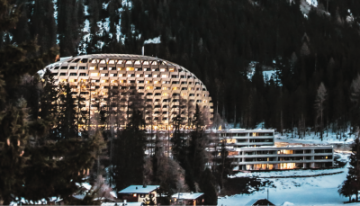 In the mid-1880s, goldsmith Peter Carl Fabergé was commissioned by the head of the Russian Imperial Romanov family to create a precious golden egg as an Easter present for his lady love. To the Empress’ delight, Fabergé’s fabled Hen Egg hid an inner sanctum of surprises, including a golden yolk and a miniature diamond replica of the Imperial Crown. The Empress was — at least up to that point in the imperiled history of the House of Romanov — one lucky woman.
In the mid-1880s, goldsmith Peter Carl Fabergé was commissioned by the head of the Russian Imperial Romanov family to create a precious golden egg as an Easter present for his lady love. To the Empress’ delight, Fabergé’s fabled Hen Egg hid an inner sanctum of surprises, including a golden yolk and a miniature diamond replica of the Imperial Crown. The Empress was — at least up to that point in the imperiled history of the House of Romanov — one lucky woman.
Fast forward a century and that Fabergé egg may well have been the inspiration for a hotel in ski country; one situated in the Swiss Alps, and one with aesthetics both outside and in resembling the Empress’ golden gift. It’s called the InterContinental Davos.
Nicknamed the Golden Egg, presiding over Switzerland’s highest city, and hiding all sorts of oligarch goodies, this odd rendition of a “Swiss chalet” is, indeed, something to behold.
It debuted in 2013, the masterpiece of architectural firm OIKOS of Munich. It was a five-star solution to
a perceived lack of hotels fine enough to host the global elite in Davos, which is in town each January for the World Economic Forum. Tony Blair. Benjamin Netanyahu. Bono. News reports have placed these political kingpins at the InterContinental’s bar, which, by the way, is perched at the very top of the hotel with spectacular views of the snowy Flüela Pass and pretty Lake Davos [pronounced da-VOSE].
The hotel’s oval facade, formed from nearly 800 giant bands of curved steel, is otherworldly enough. (At its launch, the building’s polarizing design was likened to everything from a dome, to a spaceship, to a pine cone lying peacefully on the floor of a Swiss forest.) Yet like every good egg, it’s what’s inside that counts; on this score, the InterContinental doesn’t disappoint.
 Interiors are modern and sleek, with smooth marble surfaces, glassy fronts, and strings of twinkling lights. Rooms have fur pillows and throws, floor-to-ceiling windows, opulent baths, and spacious balconies offering snapshots of Davos’ slopes.
Interiors are modern and sleek, with smooth marble surfaces, glassy fronts, and strings of twinkling lights. Rooms have fur pillows and throws, floor-to-ceiling windows, opulent baths, and spacious balconies offering snapshots of Davos’ slopes.
Food ranges from alpine cuisine cooked in the open kitchen of Capricorn, to a mix of internationally inspired tapas served on the tenth floor’s Studio Grigio: Peking duck döner, teriyaki tuna, risotto with mountain herbs, and Belper Knolle cheese.
In the hotel’s plush rental shop there’s a silky selection of handmade Zai skis designed by Switzerland’s Simon Jacomet. These lovelies are just what one needs for the Davos slopes. This ski region in the Eastern Alps encompasses six areas in total, 58 lifts, and 186 miles of terrain. Its anchor is a ski area called Parsenn, which connects the city of Davos with neighboring Klosters, a haunt of British royals.
 The hotel’s 1,200-square-foot Alpine Spa is another inner treasure. Swiss pine foot baths, moor mud back massages, herbal salt scrubs, products from La Prairie — it’s a skier’s sanctuary amid the Swiss Alps.
The hotel’s 1,200-square-foot Alpine Spa is another inner treasure. Swiss pine foot baths, moor mud back massages, herbal salt scrubs, products from La Prairie — it’s a skier’s sanctuary amid the Swiss Alps.
Still, it is the InterContinental’s art décor that catches the eye most often. Bearing the theme Deep Alpine Space, collections of paintings, drawings, sculptures, and more are scattered throughout this futuristic hotel’s rooms, restaurants, and corridors. Artists featured include Florian Borkenhagen, Simon Wassermann, and Peter Riek. The crowning piece: Moritz Waldemeyer’s Wave Chandelier in the foyer of the hotel — 400 spheres of hand-blown glass appearing in a lighted swirl that mimics the shape of a gust of snow.
Alas, there is no Fabergé egg hidden within the inner sanctums of InterContental Davos, but there are enough golden moments to score an Empress’ delight.
intercontenentaldavos.com
Lori Knowles
Related Posts
Nothing found.

